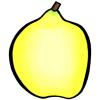Product Description
Maturity and Quality
Change of skin color from green to yellow is the primary maturity index. Quinces should be picked when full-yellow and firm.
- Size, color, freedom from defects and decay
- Quinces must be handled carefully as they bruise easily
- Quinces are not eaten fresh because of their astringency (due to high tannin content)
Postharvest Handling and Storage
0°C (32°F); Highest freezing point = -2°C (28.4°F). Storage potential = 2-3 months
Climacteric respiratory pattern.
| Temperature | 0°C (32°F) | 10°C (50°F) | 20°C (68°F) |
| ml CO2/kg·hr | 2.3-5.2 | 10.2-14.1 | 21.2-39.0 |
To calculate heat production multiply ml CO2/kg·hr by 440 to get Btu/ton/day or by 122 to get kcal/metric ton/day.
Ethylene (100ppm) treatment for 2 days at 18-21°C (65-70°F) and 90-95% relative humidity can be used after removal from cold storage to stimulate more uniform and faster ripening of quinces before processing.
90-95%
| Temperature | 0°C (32°F) | 10°C (50°F) | 20°C (68°F) |
| µl C2H2kg·hr | 2.3-6.1 | 6.9-7.4 | 11.0-31.9 |
Disorders
No published information.
Blue mold. Caused by Penicillium expansum, is the most common postharvest disease of quinces. Control strategies include careful handling to minimize wounding, prompt cooling to 0°C (32°F), and maintenance of optimum temperature and relative humidity during storage.



